What follows is a more-or-less random selection of Halloween-themed ephemera. Books, short stories, films and screenplays are all represented in a round-up that doesn’t claim to be in any way the greatest or most definitive such listing, but will at least keep you busy.
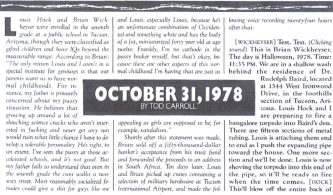 We’ll start with “October 31, 1978” by TOD CARROLL, which appeared in the late National Lampoon magazine’s October 1980 “Aggression” issue. If the tale seems unaccountably dark for a humor-oriented publication, that’s probably because the Lampoon’s overall content in the late seventies-early eighties tended toward the dour (the editor-in-chief at the time was P.J. O’Rourke, who by his own admission “killed” the mag).
We’ll start with “October 31, 1978” by TOD CARROLL, which appeared in the late National Lampoon magazine’s October 1980 “Aggression” issue. If the tale seems unaccountably dark for a humor-oriented publication, that’s probably because the Lampoon’s overall content in the late seventies-early eighties tended toward the dour (the editor-in-chief at the time was P.J. O’Rourke, who by his own admission “killed” the mag).
Very much in the mode of John Hughes’ notorious Lampoon submission “A Boy’s Wrath” (which also appeared in 1980), “October 31, 1978,” like Hughes’ fearsome tale, involves children wreaking an unbelievable rampage of destruction. The kids in this case are a pair of academically gifted seventh graders who on Halloween night, 1978 decide to ramp up the standard childish pranks. The ensuing events are related in the form of a transcription of voice recordings by the punks, who get ahold of some high grade military equipment for use against the home of the much-hated town doctor, which leads to vandalism, kidnapping, attempted murder and mass explosions in a story that (to be charitable) never quite reaches its full potential. I’d recommend the abovementioned Hughes story in its place, or even “Halloween Rampage,” another Hughes tale that appeared in the same National Lampoon issue as the present one.
SEASON OF SCREAMS from 2004 is of interest because it’s currently the only feature-length documentary about the Knott’s 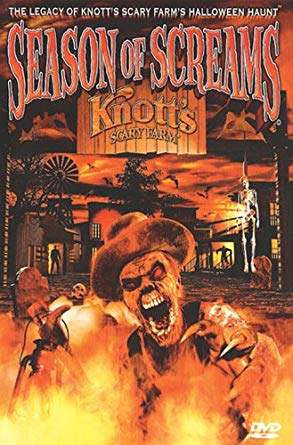 Scary Farm Halloween Haunt. I (and certainly this guy) have a special interest in the subject matter, and SEASON OF SCREAMS stands as an enjoyable overview of a most unique So Cal institution.
Scary Farm Halloween Haunt. I (and certainly this guy) have a special interest in the subject matter, and SEASON OF SCREAMS stands as an enjoyable overview of a most unique So Cal institution.
The pic is hosted by a perky blonde women who takes us through the founding and early days of Knott’s Berry Farm (complete with vintage photos and movie clips), and how in the early 1970s several employees decided to put on a Halloween party with the blessing of Mr. Walter Knott himself, apparently the only one of the Knott higher-ups who saw any merit in the idea. From there the Haunt grew into the mammoth institution it is today, and this exhaustive 138-minute film explores damn near every aspect, from the nighty “Hanging” skit to the “street” and “maze” monsters to the elaborate make-up applications undergone by both groups and the “sliding” scares, which, as we’re shown, require a great deal of practice.
Included are interviews with Halloween Haunt talent, management and even a few fans, all of whom talk up the event like it’s the greatest thing in the world. This means the doc is essentially a puff piece (and one that woefully ignores the oft-brutal realities of working the Haunt), but as such it is undeniably well done.
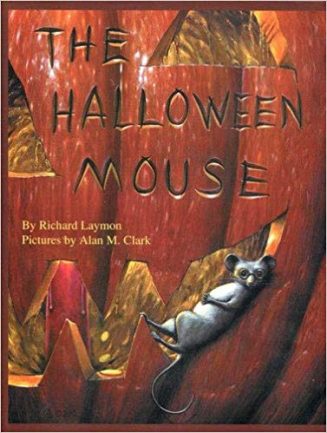 For the child-minded we turn to THE HALLOWEEN MOUSE, a short, profusely illustrated (by Alan M. Clark) kid book put out by Cemetery Dance in 2001. It’s of interest to me because it was written by the late RICHARD LAYMON, who at least made a concerted effort to adapt his talents to the kid-lit market.
For the child-minded we turn to THE HALLOWEEN MOUSE, a short, profusely illustrated (by Alan M. Clark) kid book put out by Cemetery Dance in 2001. It’s of interest to me because it was written by the late RICHARD LAYMON, who at least made a concerted effort to adapt his talents to the kid-lit market.
It relates the adventures of Timothy Usher Mouse, a young rodent who lives in a library and longs to have adventures like those described in the books contained therein. One Halloween night Timothy ventures outside, where he’s pursued by a snake and a cat, is scared by kids trick-or-treating and gets caught inside a jack-o-lantern. Laymon’s voice is evident in the highly concentrated prose and abundance of single-sentence paragraphs, but he never quite attains the type of childish whimsy for which he was so obviously striving. There are some pleasingly imaginative touches, though.
The 1998 paperback HALLOWEEN: WHAT’S A CHRISTIAN TO DO?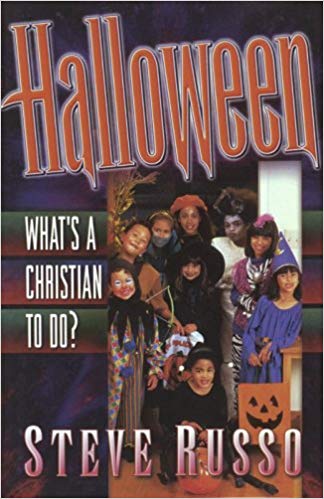 by STEVE RUSSO is a Christian-oriented screed about the evils of Halloween and what the faithful can do to stay in God’s good graces during this most sinful of seasons. It’s an extremely short book with a lot of padding, as evinced by the fact that the author’s conclusions about Halloween (which apparently “falls into the gray area of Christian living that is not specifically forbidden in the Bible”) and advice about what to do on October 31 (giving out Christian tracts to trick-or-treaters, throwing Christian-themed costume parties, etc.) is dispensed with in a couple of chapters that fall near the end of the book. Much of the rest is taken up with rambling anecdotes about the history of Halloween, Satan’s true nature (which as you might guess isn’t too endearing), the modern school system’s apparent infiltration by new age values (“What was once supposed to be a safe haven of learning has now turned into an occultic minefield of indoctrination and conversion”) and a couple lengthy glossaries of occult terminology. It’s not much of a book, in short, although we’d probably be wrong to expect anything more.
by STEVE RUSSO is a Christian-oriented screed about the evils of Halloween and what the faithful can do to stay in God’s good graces during this most sinful of seasons. It’s an extremely short book with a lot of padding, as evinced by the fact that the author’s conclusions about Halloween (which apparently “falls into the gray area of Christian living that is not specifically forbidden in the Bible”) and advice about what to do on October 31 (giving out Christian tracts to trick-or-treaters, throwing Christian-themed costume parties, etc.) is dispensed with in a couple of chapters that fall near the end of the book. Much of the rest is taken up with rambling anecdotes about the history of Halloween, Satan’s true nature (which as you might guess isn’t too endearing), the modern school system’s apparent infiltration by new age values (“What was once supposed to be a safe haven of learning has now turned into an occultic minefield of indoctrination and conversion”) and a couple lengthy glossaries of occult terminology. It’s not much of a book, in short, although we’d probably be wrong to expect anything more.
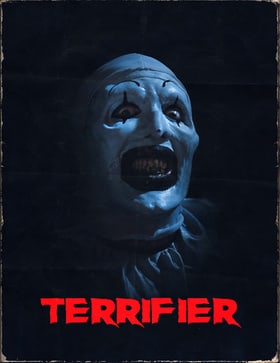 TERRIFIER, from 2011, is a short film that partook of the retro grindhouse aesthetic popularized by the Tarantino-Rodriguez GRINDHOUSE. This means it was very consciously patterned after the so-called grindhouse pictures of the 1970s, down to the washed-out colors and fake scratches. The illusion of a 1970s exploitation film is better sustained in TERRIFIER than in most of the other GRINDHOUSE wannabes, particularly in the tone, which forsakes the expected forced campiness; quite simply, writer-director Damien Leone was not kidding.
TERRIFIER, from 2011, is a short film that partook of the retro grindhouse aesthetic popularized by the Tarantino-Rodriguez GRINDHOUSE. This means it was very consciously patterned after the so-called grindhouse pictures of the 1970s, down to the washed-out colors and fake scratches. The illusion of a 1970s exploitation film is better sustained in TERRIFIER than in most of the other GRINDHOUSE wannabes, particularly in the tone, which forsakes the expected forced campiness; quite simply, writer-director Damien Leone was not kidding.
The no-frills narrative, which as in the actual grindhouse pics of old is minimalistic in the extreme, features a young woman on Halloween night getting stalked by a lunatic in a clown mask. Yes, that about sums up the entire movie, which ends with a profoundly nasty image I guarantee you’ll be a long time forgetting.
This film, incidentally, was made into a misguided feature in 2016, but I say you’re better off with the material in its original and definitive 20 minute form.
HALLOWEEN MASKS, an ebook from 2017, consists of three solid-if-unexceptional stories by the talented JEFFREY 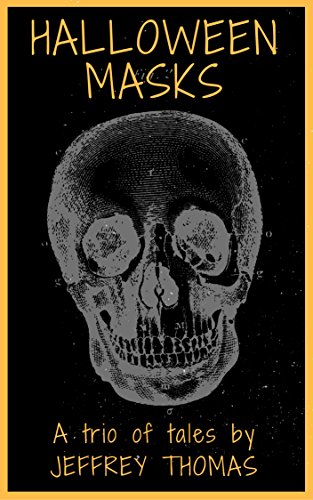 THOMAS. It commences with “The Yellow House,” about a foreboding yellow painted house owned by a crazy old man with a questionable history. The first person protagonist decides to pay a visit to the place on All Hallow’s Eve, where a most unsettling secret is revealed.
THOMAS. It commences with “The Yellow House,” about a foreboding yellow painted house owned by a crazy old man with a questionable history. The first person protagonist decides to pay a visit to the place on All Hallow’s Eve, where a most unsettling secret is revealed.
Next up is “Post #153,” which takes place in an eatery on Halloween night. The place is stocked with war veterans whose relative harmony is interrupted by what appear to be mischievous trick or treaters outside, in a story whose increasingly horrific arc closely resembles that of Robert McCammon’s classic “Nightcrawlers.”
Finally there’s the notably subdued and melancholy “October 3 2 nd,” a mood piece about a depressed man on Halloween night, when “the gate between the living and the dead was still open…The two realms were still in communion, overlapping.” This would appear to be proven by the many odd and inexplicable things the protagonist sees, while he himself remains “a prisoner chained in the dungeon of the mundane.”
Last but definitely least in this overview is HALLOWEEN IV, an unfilmed 1986 screenplay by the late DENNIS ETCHISON (a.k.a. Jack Martin, who was credited with writing the novelizations of HALOWEEN II and III). Anyone hoping for a hint of the literary brilliance with which Etchison made his name will be disappointed, as despite a few recognizable elements (such as a convenience store setting, a mainstay in Etchison’s fiction that recurs throughout the script) this was all-too-evidently a for-hire job.
That’s not to say that Etchison doesn’t strive for an extra dimension. Indeed, part of the problem here is that the script is far too ambitious for a proper sequel to HALLOWEEN, which, let’s not forget, worked primarily because of its simplicity, being about a young women being stalked by a guy in a featureless white mask. That guy, a.k.a. “The Shape,” returns, only to assume the status of a supporting player in an overly crowded retinue of characters who include policemen, news reporters, various authority figures, mischievous teens and Lindsey, the little girl from the first HALLOWEEN who’s now a teenager.
Peppering this overstuffed saga are the expected killings perpetrated by the Shape, something for which Etchison, an outspoken proponent of “quiet horror,” had little evident flair. He also tries for a NIGHTMARE ON ELM STREET-like hallucinatory vibe, suggesting at certain points, the drive-in movie set climax in particular (which, in an apparent attempt at reminding us that Etchison wrote a novelization of THE FOG, is suffused by fog), that the Shape has supernatural abilities. It all adds up to a not-at-all satisfying jumble of a screenplay that fails to add anything of any worth to the HALLOWEEN saga. About the best I can say for it is that, lousy though it is, this HALLOWEEN IV isn’t much worse than the one that eventually made it to the screen.
